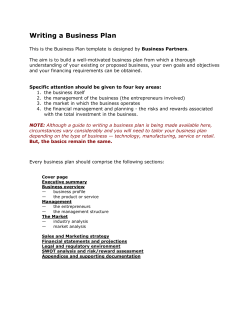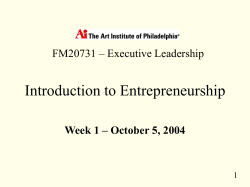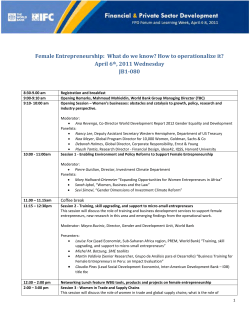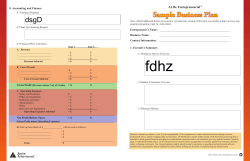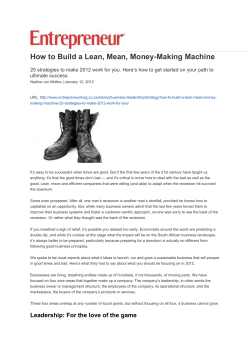
BUSINESS START-UP
BUSINESS START-UP SYLLABUS 1. THE BUSINESS ENVIRONMENT Meaning – Scope and Characteristics – Importance for economic policies and decisions in the Organisation - Types of business environment 2. THE INDIVIDUAL AS AN ENTREPRENEUR Definition- The qualities and skills of a successful entrepreneur 3. STARTING AND RUNNING A BUSINESS - Business plan - definition- How to write a business plan 4. RISKS IN A NEW BUSINESS Definition – Types 5. BUSINESS ETHICS Meaning – Scope and Characteristics – Importance Business Environment What is Business..?? Business may be understood as the organised efforts of enterprises to supply consumers with goods and services for a profit Purpose of a business All businesses share the same purpose: TO EARN PROFITS But other purposes are: Supplying goods and services to the society; creating job opportunities; offer of better quality of life; contributing to the economic growth of the country. Business objectives Before we describe business objectives, it is desirable to be clear about related concepts Vision Mission &Objectives VISION: A Vision is a broad explanation of why the firm exists and where it is trying to lead. A vision gives the organisation a sense of purpose and a set of values that unite employees in a common destiny. Creating the Vision Establishing Goals Visioning One of the most important things to do in the preparation stage is to VISUALIZE things in your mind Mayor Rudolph Giuliani Visioning vs Planning Visioning Planning proactive plan for the future It is a view of the future that everyone can believe in. - - process that provides specific direction and meaning to the day-to-day activities. strategic planning places the strategic vision into motion. A Vision Statement - Says what you want out of Business. - Details principles and beliefs. - Gives you the power to create and design your business around your values. In Summary You have to have a plan for success !!! It starts with a vision You get the vision by reaching each goal. You reach goals by hard work, dedication, and perseverance. Objectives Objectives render mission statements more concrete. Mission statements seek to make a vision more specific and Objectives are attempts to make mission statements more concrete. Objectives therefore, represent the operational side of an organisation. Profit: Profit is the main incentive, motivator, strong sustainer, judicious allocator of resources, objective indicator of productivity and a solid basis for growth, expansion and survival. Growth: Business should grow in all directions over a period of time. The strategies adopted to achieve growth are: (a) add more products/markets; (b) diversify into new areas; (c) increase market share; (d) cut down costs and increase productivity. Power: Business houses have vast resources at its command. These resources confer enormous economic and political power on owners and managers of business ventures. Employee satisfaction & Development: Concern for employees continues to be an important aspect of management Quality products & services: Those who insisted on and persisted in quality survived competition and stayed ahead of others in the market. Persistent quality of products earns brand loyalty, a vital ingredient of success. Market Leadership: To earn market leadership, innovation is the key factor. Innovation may be in product, advertising, distribution, finance or in any other field. Challenging: Business offers vast scope and poses formidable challenges. Joy of creation: It is through business strategies new ideas and innovations are given a shape and are converted into useful products and services for the benefit of customers. Service to society: Business is a part of society and has several obligations towards it. Good Corporate citizenship: It implies that the business unit complies with the rules of the land, pays taxes to the government regularly, discharges its obligations to society and cares for its employees and customers. What is environment..?? Circumstances, influences, stresses, and competitive, cultural, demographic, economic, natural, political, regulatory, and technological factors (called environmental factors) that effect the survival, operations, and growth of an organization. Business Environment Definition of Business environment by Davis Keith “ The Aggregate of all conditions events and influences that surround and affect business.” Business environment refers to all those internal and external factors that have a bearing on the business. Characteristics of Business environment. Business is the surrounding situation that affect the business. Business environment is very Complex and needs a deep study. Dynamic nature is one of the part of business environment. Study of changes is very important for the business. Environment = Opportunities & Threats Environment is very complicated and Hence it needs minute study. Characteristics of Business environment. Changes in the environment cant be done by one businessman. Businessman has to adjust to the environment. Creates framework for business. It’s a challenge and an opportunity for the business man and its study can help make or brake the business. As the business environment is very complex and cannot be changed hence It needs adaptability. Need & Importance of Business Environment. The study of Business Environment helps keeping the business flexible. To exploit business opportunities fully. need & Importance of Business Environment. To make business socially acceptable. To keep the business enterprise alert. To maintain adaptability to socio-economic changes. To understand future problems and prospects. To ensure optimum utilization of resources. Types of Business Environment. Three different levels of Business Environment are as follows: Internal Environment Micro Environment Macro Environment INTERNAL ENVIRONMENT The important internal factors which have a bearing on the strategy and other decisions are: 1. Value system 2. Mission & Objectives 3. Management Structure & Nature 4. Internal Power relationship 5. Human resources 6. Company image & Brand equity MICRO ENVIRONMENT The micro environment consists of the actors in the company’s immediate environment that affect the performance of the company. Suppliers: Suppliers are the important force in the task environment of a business. Multiple sources of supply often help to reduce risks. Customers: To succeed in capturing customers, a business must try its best to know what people want and will buy. Labour: The labour force is organised in the form of trade unions. The trade unions interact with the management & pressurise the management for the fulfilment of their demands. Competitors: Competitors play a vital role in running the business enterprise. There are various types of competitions: Desire competition: Under this type of competition the primary task is to influence the basic desire of the customer. Generic competition: The competition among alternatives which satisfy a particular category of desire is called generic competition. Product form competition: In this type of competition, the consumer has to choose between different forms of the product. Brand competition: The competition between different brands of the same product. Taking into consideration these different factors every marketer should strive to create primary and relative demand for his product. Regulating agencies: The regulators include government departments and other organizations which monitor the activities of business. MACRO ENVIRONMENT Political Demographic International Economic Business Environment Natural Technological Social Types of Business Environment The macro forces are, generally, more uncontrollable than the micro forces. Important macro environment factors includes: Political Environment. Economic Environment. Social Environment. Technological Environment. Natural Environment. International Environment. Demographic Environment. ECONOMIC ENVIRONMENT The survival & success of a business enterprise is finally decided by the economic environment & various market conditions. The important external factors that affect the economic environment of a business are as follows: Economic conditions Economic policies Economic growth Interest rates Currency exchange rates. SOCIO-CULTURAL ENVIRONMENT It is very comprehensive because it may include the total social factors within which an organisation operates. Socio-cultural environment may include expectations of the society from business, attitudes of society towards business & its management, views towards achievement of work, views towards structure, responsibility & organisational positions, views towards customs, & labour mobility & level of education. NATURAL ENVIRONMENT It includes geographical & ecological factors. Almost every aspect of business depends upon natural environment. Manufacturing depends on physical inputs. Mining depends on nature Agriculture depends on nature. Trade between two regions depends on geographical factors. Topographical factors may affect the demand pattern. DEMOGRAPHIC ENVIRONMENT It includes: Size, growth rate, age composition, sex composition etc., of population Family size Caste, religion, Educational level...etc TECHNOLOGICAL ENVIRONMENT Business has to adopt technological changes from time to time. Every business enterprise has two basic functions i.e., Marketing & Innovation. Technological environment also includes research base decisions. The fast changes in technology also create problems for enterprises as these render plants and products obsolete quickly. International Environment Implications of global or international environment are as follows: Companies are forced to view business issues from a global perspective. Safe & protected markets are no longer there. Learning of foreign languages is a must for every business manager. Acquiring familiarity with foreign currencies is also a must. THE INDIVIDUAL AS AN ENTREPRENEUR What is “entrepreneurship”? Why be an entrepreneur? Why not? Categories of Entrepreneurs Characteristics and Skills of an Entrepreneur Entrepreneurship - Some Modern Definitions Scott Shane (Case Western) – “Entrepreneurship is an activity that involves the discovery, evaluation and exploitation of opportunities to introduce new goods and services, ways of organizing, markets, processes, and new materials through organizing efforts that previously had not existed.” Howard Stevenson (Harvard) – “.. The pursuit of opportunity without regard to resources currently controlled.” • An entrepreneur is a person who seeks a profitable opportunity and takes the necessary risks to set up and operate a business. • Differ from many small-business owners in their strong desire to make their business grow. • Differ from managers through their overriding responsibility to use the resources of the organization to accomplish their goals. • Willing to take risks. QUESTION Why be an entrepreneur? What do you think? Why should you be interested? Many young people have succeeded: Michael Dell - Dell Computers Frank Carney - Pizza Hut Fred De Luca - Subway. Kristy Taylor - SkinCareRx.com Opportunity to reap large profits Why should you be interested? Invulnerability of Youth Confident, resilient, and ignorant Minimum exposure to failure Limited Responsibility Marriage, children, car, home, etc. suggest higher opportunity costs if failure Physical and Emotional Strength Better ability to burn the candle at both ends Why should you be interested? Available Resources Many are waiting for you to ask for help. Take advantage of your “harmless” appearance Opportunity to control own destiny Opportunity to reach your full potential Opportunity to make a difference Why NOT to be an Entrepreneur Uncertainty of income Risk of losing entire invested capital Lower quality of life until business gets established High levels of stress Complete responsibility Why People Become Entrepreneurs Why People Become Entrepreneurs Being your Own Boss Self-management is the motivation that drives many entrepreneurs. Financial Success Entrepreneurs are wealth creators. Job Security Over the past ten years, large companies have eliminated more jobs than they have created. Quality of Life Starting a business gives the founder some choice over when, where, and how to work. The Environment for Entrepreneurship Globalization The rapid globalization of business has created many opportunities for entrepreneurs Characteristics of Entrepreneurs Characteristics of Entrepreneurs Not everyone wants to be an entrepreneur and run their own business. Being an entrepreneur requires specific characteristics and skills that are often achieved through education, hard work, and planning. Risk Taker - Businesses face risk. Entrepreneurs minimize risk through research, planning, and skill development. Perceptive - Entrepreneurs view problems as opportunities and challenges. Curious- Entrepreneurs like to know how things work. They take the time and initiative to pursue the unknown. Imaginative - Entrepreneurs are creative. They imagine solutions to problems that encourage them to create new products and generate ideas. Persistent- True entrepreneurs face bureaucracy, make mistakes, receive criticism, and deal with money, family, or stress problems. But they still stick to their dreams of seeing the venture succeed. Goal-setting - Entrepreneurs are motivated by the excitement of staring a new business. Once achieved, they seek out new goals or ventures to try. Hardworking - Entrepreneurs need a great deal of energy to see a venture start and succeed. Yet they are not deterred by the long hours to achieve their goal. Self-confident - Entrepreneurs believe in themselves. Their self-confidence takes care of any doubts they may have. Flexible - Entrepreneurs must be flexible in order to adapt to changing trends, markets, technologies, rules, and economic environments. Independent - An entrepreneur’s desire for control and the ability to make decisions often makes it difficult for them to work in a controlled environment. Entrepreneurial Skills A skill is the ability to do something specific or to translate knowledge into action. Research Skills: Entrepreneurs need to identify what they need to know and use research techniques to obtain it. Gathering Information • Reliable and relevant sources of information may include: books, periodicals, indexes and databases, the Internet, consultants, professionals, schools. Relationship Skills: Running a business means building good relationships with staff, suppliers, and customers. Staff Relationships : Employees need to feel that they are treated fairly, are rewarded for their efforts, and have their needs met. Supplier Relationships: Communication is the most important relationship skill required to deal with suppliers. They act as sources of information for the new business. Suppliers also require feedback to know how to improve their service. Customer Relationships: In an entrepreneurial business, the customer is the “boss” and the key to the business’ success. Therefore, the entrepreneur and his or her staff must develop a positive relationship with the customer STARTING AND RUNNING A BUSINESS Entrepreneurs Start Businesses: To Capitalize on an Invention To Pursue a Passion To Be Their Own Boss To Get Rich ---All Need an Exit Strategy Why develop a Business Plan? “All the work you do in thinking up your idea, testing it, studying it, and producing it, has been for nothing if you can’t sell it. Whether you start you own business to produce and sell your invention, subcontract out the manufacturing part, or sell your rights in return for a percentage of the proceeds, you need a business plan.” - Pamela Riddle Bird, PhD, Inventing For Dummies Why develop a Business Plan? “A business plan is vital for enterprises needing investment, grant funding or significant borrowing; more so for innovation ventures, as the greater number of ‘unknowns’ makes it even harder to attract backing. But don’t make the mistake of thinking that only other people need your business plan. It’s primarily a tool to reveal possibly awkward truths about your business to you.” - a Creative Investor Definition: A business plan is a formal statement of a set of business goals, the reasons you believed they are attainable, and the plan for reaching those goals. It may also contain background information about the organization or team attempting to reach those goals. Types of Plans Summary Plan 10 pages, 3 important points Comprehensive Plan 10-40 pages, seeking capital or alliances Operational Plan 40+ pages, for going concerns, part of an annual process The Summary Plan The Business Legal Structure, Products or Services, Management, Personnel, Record Keeping Marketing Target Market, Competition, Advertising Financials Summary of Needs, Use of Funds, 3 Year Cash Flow Projections, Income Projections Business Plan Content Executive Summary Company Description Product/Services Description Industry Overview Market Analysis Competitors Business Plan Content Customers Marketing and Sales Plans Development Operations Management Business Plan Content Personnel Financial Summary Financials Offering Appendices Executive Summary A mini-business plan in one or two pages Highlights the most important points of your business plan It is NOT an introduction to the plan It must grab your reader, and entice him/her to read further Executive Summary Identify the company, its background, structure and location Describe what the company does, and the market it serves Describe the market potential for the company’s products and services, market trends, etc. Executive Summary Outline the backgrounds and experience of the top management team Describe the funding required, the purposes for which it will be used, the collateral available (if for a lender), and the expected outcomes Company Overview Brief Company Introduction Mission statement Location, size, history Market and products Overview of company capabilities Objectives Products/Services Products / Services What does it do? Uniqueness Competitive Advantage Technology Brief description Applications Commercialization Status Brief overview Industry Overview Set The Stage Industry Definition and Description Major players within the industry Factors driving dynamics New products and developments Legislation and Policies Driving the Industry Historical and Future Trends Market Analysis Market Definition Primary Market Secondary Markets Market Size and Trends Current total revenues Predicted annual growth rate Competitors Direct Competitors Who are they? Size and product breadth Revenues and profitability Strengths and weaknesses Market shares Indirect Competitors Marketing Strategies Product/Service Strategy Pricing Strategy Distribution Strategy Advertising and Promotion Strategy Sales Strategy Marketing and Sales Forecasts Marketing and Sales Plans Statement of Opportunity Marketing and Sales Objectives Existing Customers Potential Customers Prospects targeted How prospects will be targeted and qualified Marketing and Sales Plans Marketing Programs Direct Mail Trade Shows Advertising Internet Publicity/Public Relations Marketing Budget Pricing Basis for targeted price point Margins and profitability by volume levels Marketing and Sales Plans Sales Plan Sales force structure – (direct or reps) Sales expectations/quotas Margins given to intermediaries Service and warranties Sales Budget Organizational chart indicating planned growth Development R & D Plan Objectives Milestones and current status Difficulties and risks Staffing R & D Budget and assumptions Operations Manufacturing/Production Plan Objectives Facilities Staffing Subcontractors Quality Control Budget / Operating Expenses Management Company Organization Management Team Administrative Expenses Personnel Human Resource Plan Staffing Objectives Organizational Structure 3-5 year growth plan Budget Summary of Financials Financial Objectives Time to Cash Flow Positive Time to profitability Financial Assumptions Capital Requirements Exit Scenario Appendices Resumes of Key Management Patent Information Customer List Testimonials Supplemental Financial Spreadsheets References Risks in a new business Kinds of Risks 3 Types Economic Natural Human Financial Risks These risks occur from changes in overall business conditions. This can include: amount or type of competitor(s) changing consumer lifestyle population changes government regulations inflation recession Natural Risks Natural risks are result from natural disasters or disruptions floods tornadoes hurricanes fires droughts lightning earthquakes even sudden abnormal weather conditions Human Risks These are caused by human mistakes and errors, as well as the unpredictability of customers, employees, or the work environment This could include: Theft injury on the job bad checks employee error Negligence Incompetence BUSINESS ETHICS Ethics and Ethos The word “ethics” is derived from the Greek ethos, meaning “customary” or “conventional.” To be ethical in the sense of ethos is to conform to what is typically done, to obey the conventions and rules of one’s society and religion. What is ethics? Ethics is the branch of philosophy that focuses on morality and the way in which moral principles are applied to everyday life. Ethics has to do with fundamental questions such as “What is fair?” “What is just?” “What is the right thing to do in this situation?” Ethics involves an active process of applying values, which may range from religious principles to customs and traditions. What is business ethics? Business ethics focuses on what constitutes right or wrong behavior in the world of business. Corporate business executives have a responsibility to their shareholders and employees to make decisions that will help their business make a profit. But in doing so, businesspeople also have a responsibility to the public and themselves to maintain ethical principles. Although ethics provides moral guidelines, individuals must apply these guidelines in making decisions. Ethics that applies to business (business ethics) is not a separate theory of ethics; rather, it is an application of ethics to business situations. Although all people have ethical responsibilities, higher ethical standards are imposed upon professionals who serve as social models, such as physicians, attorneys, and business people. The Nature & Goals of Business Ethics Business ethics refers to those values, standards and principles that operate within business. Business ethics is also an academic discipline that studies those standards, values and principles while seeking to articulate and defend the ones that ought or should operate in business. Ethical Judgment vs. Behavior From the time of Aristotle we have noticed a discontinuity between judging some act as right and behaving rightly. Knowing what is right is different from doing what is right. People vary in strength of character and motivation and fortitude. Reasoning and Business Ethics The process of ethical reasoning must be emphasized. Reasoning is distinct from answers. Begin with an accurate and fair account of the facts from all “sides”. Be objective and open-minded. Analyze each issue fully and rigorously. The Relationship Between Law and Ethics The law is an expression of the ethical beliefs of our society. Law and ethics are not the same thing. The question, “Is an act legal?” is different from the question, “Is an act ethical?” The law cannot codify all ethical requirements. Therefore, an action might be unethical, yet not necessarily illegal. For example, it might be unethical to lie to your family, but it is not necessary illegal. Ethical perspectives Managerial ethics: What should a business manager do in various situations? The types of questions asked will vary from perspective to perspective. All decisions faced by business managers, from finance to marketing to ethics and human resources, exist in a social and legal context. Ethics as Good Business Unethical business practices include: Lying Offering merchandise known to be substandard Treating customers or employees unfairly Conflicts of Interest Conflict of interest is a major ethical question that is generally not illegal conflict of interest a conflict between self-interest and professional obligation Ethical Questions Is it against the law? Does it violate company or professional policies? Even if everyone is doing it, how would I feel if someone did this to me? Am I sacrificing long-term benefits for short-term gains? Reflections on the chapter A wide range of people can be adversely affected by the decision made within contemporary business. There are many roles to play within the economic system to insure integrity of that system and to prevent fraud and abuse. Business operates within a social context and has duties to a wide range of people beyond those people who own a company’s stock. Thank you! Multumesc!
© Copyright 2025


